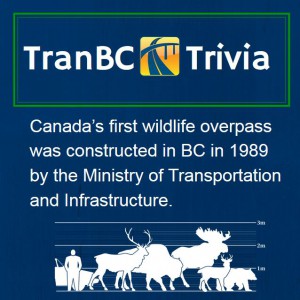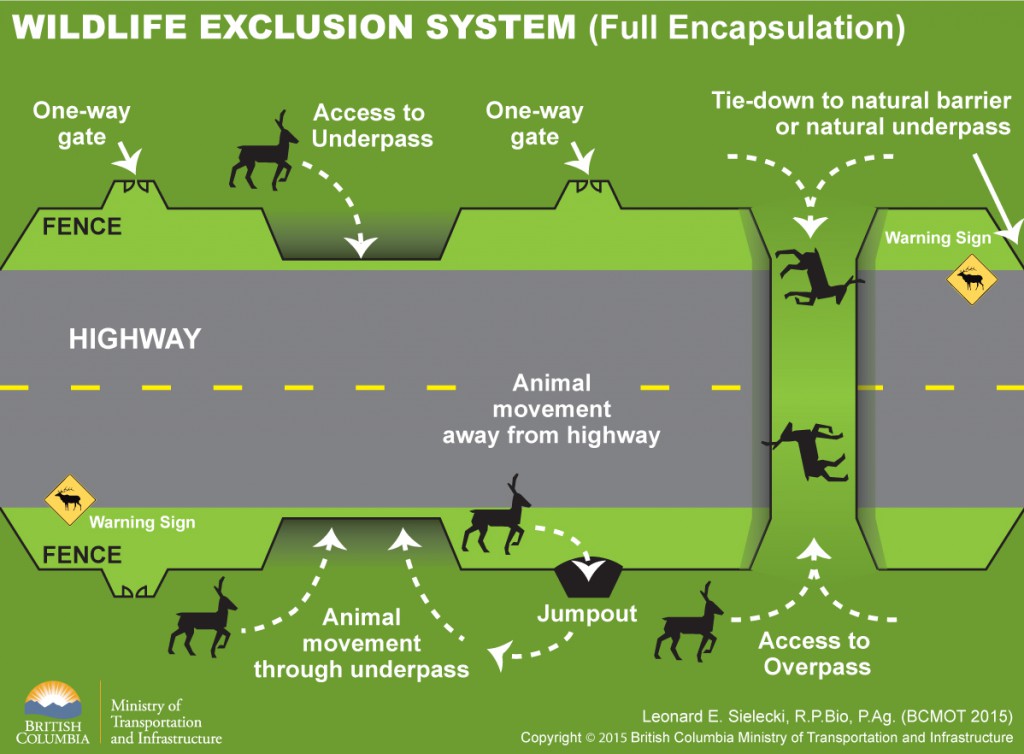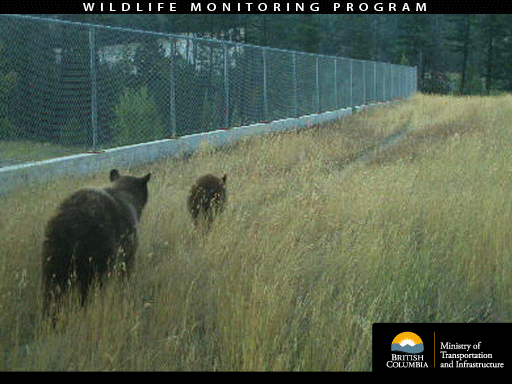Wild animals love British Columbia. Of course they do – it’s varied terrain makes it a haven for beasts and creatures of all shapes and sizes. Both small and large species, from the gigantic moose to the night-crawling raccoon, pose potential hazards for drivers, and vise versa. A large animal can make a serious impact, while a smaller animal can startle a driver into swerving and losing control of their vehicle.

It’s our job to prevent animals and drivers from crossing paths, and the wildlife overpass is just one of the ways we do this.
Along with wildlife underpasses, which we wrote about in a previous post, overpasses give wildlife safe passage to important seasonal habitats. Healthy wildlife populations flourish when ecosystems remain connected, and wildlife overpasses help achieve that. Think of them as “wildlife freeways,” keeping animals moving while preventing collisions with vehicles.
Where to put them?
Our wildlife experts are instrumental in determining overpass locations. They work closely with bridge engineers on the design of the structures, and with geotechnical engineers on the final location. Overpasses are built after extensive wildlife habitat surveys, wildlife tracking surveys, wildlife population surveys, and analysis of wildlife accident locations using the ministry’s WARS data.
Part of a bigger wildlife transportation network
Wildlife overpasses are a big part of the wildlife exclusion systems we use to protect motorists and wildlife on BC highways. Other parts of exclusion systems include:
- Exclusion fencing
- One-way gates
- Jump outs (basically, raised ramps that allow animals who find themselves on the wrong side of the fence to jump out to the protected side)
- Ungulate guards

Our maintenance contractors also keep the grass and brush short along the highway to allow drivers to see when any animals do come close to the road.
Watch this cool time lapse video of snow load monitoring, captured on the Coquihalla during the winter of 2021.
Snow load monitoring is part of the Ministry of Transportation and Infrastructure’s Wildlife Exclusion System Improvement Program and a key part of our efforts to improve wildlife exclusion system design and performance. Winter conditions on the Coquihalla are some of the most challenging in the world and our ministry engineers have worked with BC material suppliers to design wildlife exclusion fencing that can withstand the full wrath of Mother Nature during her winter season. The ministry’s maintenance contractors maintain the wildlife exclusion fencing every spring.
We estimate that a well-designed, well-constructed and well-maintained wildlife exclusion system can reduce the potential for wildlife collisions by more than 90 per cent. That’s good news, whether you travel on four wheels or four legs.
Have a question about wildlife overpasses that we didn’t answer? Let us know in the comments section below.

I’ve never seen an Overpass on Vancouver Island, and one morning counted 13 dead animals from just that night. A new Highway was built, and I’ve not seen any structure for the wildlife. The loss of animals is huge, fawns, deer, racoons, porcupines, etc. I even saw a baby cougar dead on the side of the road. Tis a Shame! Is Vancouver Island not in BC?
Hi Janice, thanks for your comments about wildlife overpasses. I will share them with our staff in the Vancouer Island District.
Perhaps off topic a bit: I see there is a note about keeping grass and brush short near roadways to improve visibility of wildlife on highway verges. However, has your team explored the rewilding of urban highway verges as a means of improving insect biodiversity?
https://www.plantlife.org.uk/application/files/6316/5168/1521/Managing_grassland_road_verges_2020.pdf
Hi Rory – thanks for your comment. Urban roadway spaces typically fall under the jurisdiction of the city in which they run through, while our responsibility falls on the stretches of highway which connect communities in BC. Many urban green spaces in BC have become demonstration gardens for plantings which support insect and bird diversity. We suggest you check out this link for more information on urban green spaces: https://vancouver.ca/home-property-development/green-streets-program.aspx
For those stretches of highway between communities, our focus is to keep grasses down to provide better sightlines for motorists and wildlife, as you mentioned. Hope that this information is helpful.
Can you please do something about the many deer that are hit by cars and killed each year in the area of the Alberni Hwy 4 and the section of highway between Hwy 4 and Qualicum downtown. Along with all Island hwy between Parksville and Qualicum area. I have seen many deer hurt, injured and suffering roadside with no one helping. We need signage, saying Slow down and more wildlife signs indicating the above mentioned area are crossing road points for the deer.
Hello Barbara – thanks for connecting with us here. We shared your concerns with our staff in the area and they will do a review of the area to make sure it is adequately signed. We also encourage you to follow up with Qualicum and Parksville as well, to make sure they review their sections of road for signage as well. We hope that this is helpful.
They need Wildlife Overpasses, not signs…..the Big Truckers won’t stop for them, or anyone else I’ve noticed. It’s high speed on the Island Hwy. Signs are NOT the answer. People know there’s wildlife, they KNOW. They all move out there to be in Nature and now it’s roadside carnage. What a mess
Hello,
Are there any plans to build a wildlife overpass anywhere along Hwy 97 between Clinton and Quesnel? There are a massive amount of wildlife deaths occurring and I am sure they are not all reported. I looked at your WARS data and Hwy 97 is by far the worst Hwy for animal collisions, however I know it is also probably the longest Hwy as well. Please advise. Thank you.
Good morning Jake,
We reached out to our environmental team and they let us know that, at this time, the ministry does not have plans to build a wildlife overpass between Clinton and Quesnel on Highway 97.
We normally consider building a wildlife overpasses when we have a major project on a highway and wildlife-vehicle collisions are a traffic safety factor. That way, the ministry can take advantage of the engineering and construction staff, and construction equipment, available with the project. We typically build wildlife overpasses in locations where wildlife habitat can be permanently connected to provincial lands on both sides of a highway. This makes building wildlife overpasses easier, much less expensive, and more effective.
Our ministry has been monitoring wildlife mortality on numbered provincial highways on a daily basis for over 35 years, is monitoring wildlife-vehicle collisions on Highway 97 and is always looking at ways of reducing these collisions to protect wildlife and motorists.
Hello, i wonder if you could consider changing the speed limit on the highway 97 from prince george to hixon 110, garden pass in nevada is 70 mph which is 110, both are similar road types and conditions
Hi Marcus,
I can certainly pass on your comments to the local area. Though we’re always monitoring highway speeds and safety, there is no plans to change speed limits at this time.
Hi Marcus,
Further to your comment (we spoke to our engineers), this section was considered during the 2014 Rural Highway Safety and Speed Review. Ministry traffic engineers evaluated operating speeds on the highway at that time and based on engineering input as well as public consultation, the decision was made to not increase the speed limit on Highway 97 between Hixon and Prince George. As mentioned before, we don’t have any plans to review the speed limit along this section of highway at this time. Thanks again.
Hi there,
I am wondering who to talk to. Would like
An animal overpass on our highway in between cities.
Can you email me back the info. Please?
Hello Vanessa,
If you could let us know where you were thinking, we can direct you to our local area staff, who will review/consider your suggestion.
I would like permission to link to webcams and use your Wildlife Exclusion System diagram to show students a real-world examples of how scientists are providing solutions to fragmented ecosystems during my Global Skype Virtual Education Session: Jr. Biologists Investigate Conservation Science.
I am showcasing the road ecology of work of USFWS and the US Dept. of Transportation. I would love to include Canadian science as well.
Hi Deb,
You’re more than welcome to show anything we’ve provided on our websites. Here’s a link to our highwaycams as well http://www.drivebc.ca/mobile/webcams/index.html
I would like permission to link to webcams and use your Wildlife Exclusion System diagram to show students a real-world examples of how scientists are providing solutions to fragmented ecosystems during my Global Skype Virtual Education Session: Jr. Biologists Investigate Conservation Science.
The session is an exploration of how conservation biologists are using scientific tools and methods to learn about and mitigate human threats to ecosystems, ecosystem services, and wildlife communities. I am showcasing the road ecology of work of USFWS and the US Dept. of Transportation. I would love to include Canadian science as well.
Hello Deb and thank you for your comment. You are free to link back to our webcams and highlight our Wildlife Exclusion System diagram, as long as the images etc. are not used for marketing/promotional/monetary gain. Please credit the BC Ministry of Transportation and Infrastructure. Thank you!
Hello, my name is Tyler from Child of God. Thank you for replying to my E-mail. I would like to ask if you would be willing to do a pod cast, phone call, or other form of communication during our presentation.We will be asking the same questions that I asked earlier. I will try to keep in touch. Thank you for your cooperation.
Hi Tyler,
One of our wildlife biologists has been in touch with you directly and we hope that this helps answer your questions. Thanks for connecting with us here and good luck with your project.
Hello, my name is Tyler from Child of God School. We are doing a project on white tailed deer. I seek answers and useful information about these questions.
When people interact with white tailed deer, is it on purpose or on accident?
Does the interaction help or hurt the people, animal, or both?
What type of professionals work with or study animals?
Do you notice any ways that the interaction could be better, more productive, healthier, or happier for both the animal and the person?
Hi Tyler,
Thanks for connecting with us here. Interactions with deer can be both accidental and on purpose, but because white tail deer are wild animals, the least amount of contact with humans, the better. Wildlife biologists would study these types of animals and for a variety of reasons. Hope that this helps.
hi im tyler im an 11 year old student at mountain view school im doing a project on turtles and wondering what kinds of turtles can survive in what conditions and is their any animal crosses for them i would love to hear back from you.
sincerely tyler
Hello Tyler,
Thanks for your message!
The Western Painted Turtle is the species of turtle that our ministry has done the most work to protect.
Habitat
Painted Turtles inhabit shallow aquatic habitats with slow-moving water, soft bottoms, aquatic vegetation, and abundant basking sites. They occur in a diversity of habitat types, including swamps, marshes, permanent or temporary ponds, creeks, rivers and lakes. In the prairies, the Western Painted Turtle tends to be associated with rivers and is uncommon in wetlands and prairie potholes. Females nest in sandy or gravelly soils in open-canopy habitats with high sun exposure, such as in forest clearings, meadows, shorelines, fields, and the shoulders of roads. The nest sites are typically within 200 m of a water body. Painted Turtles overwinter at the bottom of water bodies or under submerged undercut banks.
Biology
In Canada, Western Painted Turtles are dormant during the winter and are typically from April until late September or October. Painted Turtles nest from late May to early July. The female excavates a nest cavity and lays 4¬–23 (average 12) elliptical eggs. The number of eggs laid varies with age and size of the individual and the number of clutches produced (females usually reproduce every year, but may lay more than one clutch). The eggs hatch in the fall, approximately 2.5 months after they were laid, but some individuals overwinter in the nest before emerging the following the spring. Painted Turtle hatchlings are capable of supercooling and are freeze-tolerant, allowing them to survive sub-zero temperatures as low as −10°C in the nests. The sex of the offspring depends on incubation temperature; warmer incubation temperatures produce females and cooler temperatures produce males. In Canada, female Painted Turtles reach sexual maturity at 12–15 years of age, and males mature between 7–10 years of age. Painted Turtles can live for over 50 years in the wild, and possibly much longer. Painted Turtles are omnivorous and forage primarily during the day for invertebrates, small vertebrates like fish or frogs, carrion, and a variety of plant material. Painted Turtles bask regularly throughout the active season, especially on sunny days. Individuals may make use of multiple wetlands over the course of the year, and home ranges can be several kilometres in length.
Source: http://canadianherpetology.ca/species/species_page.html?cname=Western%20Painted%20Turtle
The ministry uses wildlife underpasses and overpasses in locations where wildlife are known to cross. Here’s a bit more on the types of creatures, like turtles, who use our underpasses: https://www.tranbc.ca/2013/03/06/a-day-in-the-life-of-a-highway-underpass-wildlife-camera/
Good luck with your project! We hope that this information is helpful.